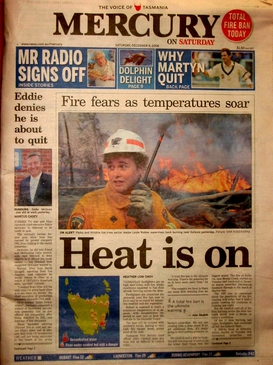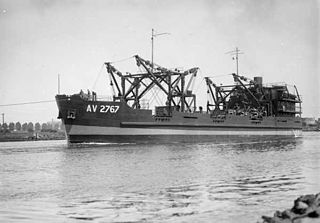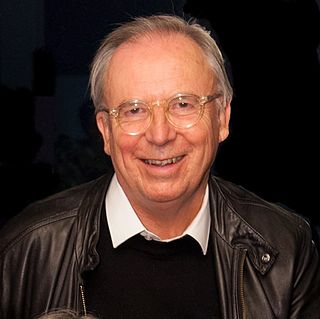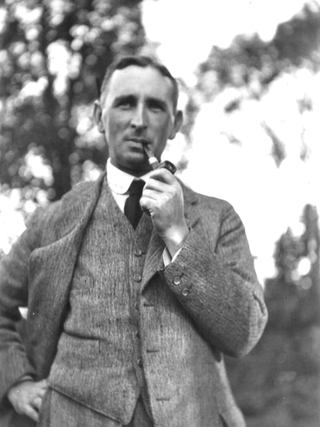
Launceston or is a city in the north of Tasmania, Australia, at the confluence of the North Esk and South Esk rivers where they become the Tamar River (kanamaluka). As of 2021, the Launceston urban area has a population of 90,953. Launceston is the second most populous city in Tasmania after the state capital, Hobart. As of 2020, Launceston is the 18th largest city in Australia. Launceston is the fifth-largest inland city and the ninth-largest non-capital city in Australia. Launceston is regarded as the most livable regional city, and was one of the most popular regional cities to move to in Australia from 2020 to 2021. Launceston was named Australian Town of the Year in 2022.
The history of Tasmania begins at the end of the Last Glacial Period when it is believed that the island was joined to the Australian mainland. Little is known of the human history of the island until the British colonisation of Tasmania in the 19th century.

John Herbert Crawford, was an Australian tennis player during the 1930s. He was the World No. 1 amateur for 1933, during which year he won the Australian Open, the French Open, and Wimbledon, and was runner-up at the U.S. Open in five sets, thus missing the Grand Slam by one set that year. He also won the Australian Open in 1931, 1932, and 1935. He was inducted into the International Tennis Hall of Fame in 1979.

Hobart College is a government comprehensive senior secondary school located in Mount Nelson, a suburb of Hobart, Tasmania, Australia. Established in 1913 as Hobart High School, it was later renamed as Hobart Matriculation College in 1965, and subsequently renamed as Hobart College. The college caters for approximately 1,000 students in Years 11 and 12 and is administered by the Tasmanian Department of Education.

Australian National Airways (ANA) was Australia's predominant aerial carrier from the mid-1930s to the early 1950s.

TheMercury is a daily newspaper, published in Hobart, Tasmania, Australia, by Davies Brothers Pty Ltd, a subsidiary of News Corp Australia, itself a subsidiary of News Corp. The weekend issues of the paper are called Mercury on Saturday and Sunday Tasmanian. The current editor of TheMercury is Craig Herbert.
Sir Roy Burman Grounds was an Australian architect. His early work included buildings influenced by the Moderne movement of the 1930s, and his later buildings of the 1950s and 1960s, such as the National Gallery of Victoria and the adjacent Victorian Arts Centre, cemented his legacy as a leader in Australian architecture.

The Australian Institute of Architects, officially the Royal Australian Institute of Architects, is Australia's professional body for architects. Its members use the post-nominals FRAIA (Fellow) and RAIA. The Institute supports 14,000 members across Australia, including 550 Australian members who are based in architectural roles across 40 countries outside Australia. SONA is the national student-membership body of the Australian Institute of Architects. EmAGN represents architectural professionals within 15 years of graduation, as part of the Australian Institute of Architects.
Australian non-residential architectural styles are a set of Australian architectural styles that apply to buildings used for purposes other than residence and have been around only since the first colonial government buildings of early European settlement of Australia in 1788.
Port Davey is an oceanic inlet located in the south west region of Tasmania, Australia.

Crusader (AV2767) was an Australian Army amphibious operations support ship of World War II. She was launched shortly before the war ended and entered service in late 1935. From 1945 to 1947 she was mainly used to return Australian Army equipment from the islands off New Guinea. She was also loaned to the Australian Shipping Board in early 1947 and transported earth moving equipment and timber between Melbourne and Tasmania. However, the Army did not need a ship with Crusader's capabilities after the war, and she was sold in 1947 to the Queensland Cement and Lime Company which operated her as a coral barge on the Brisbane River until the mid-1980s. The ship was scuttled in 1986 and became a popular dive wreck.

John Cyril "Jack" Cato, F.R.P.S. was a significant Australian portrait photographer in the pictorialist style, operating in the first half of the twentieth century. He was the author of the first history of Australian photography; The Story of the Camera in Australia (1955)

Robert William Morris-Nunn is an Australian architect.

St Andrew's Kirk, Launceston, is a Presbyterian church located on St John Street in Launceston, Tasmania, Australia, serving the Presbytery of Bass. It was the second Presbyterian church to be built in the city of Launceston following the Scotch National Church on Charles Street.

Thomas Pollard Sampson was a Tasmanian-born Australian architect active in New South Wales during the first forty years of the 20th century. His work encompassed the styles of the Federation Arts and Crafts and Bungalow through to the Inter-War Styles. In 1912 he designed an octagonal roofed stadium at Rushcutters Bay that seated up to 12,000 spectators. At the time, the Sydney Stadium was said to be "the largest roofed-in structure in the world." In the 1920s and 1930s, as a golfer and member of Concord Golf Club and Pennant Hills Golf Club, he designed the clubhouses at both courses. The buildings of both these well known Sydney clubs are still in use in 2023.
Anne Godfrey-Smith was an Australian poet, theatre director and women's activist.

The Burnie Theatre was a historic theatre in Burnie, Tasmania, Australia. The theatre, adjoining town hall, Burnie Institute and Public Library were all converted into a large FitzGerald's Department Store by 1978 and completely demolished in 2009.

The Avalon Theatre is a historic former Temperance Hall, theatre and cinema in Hobart, Tasmania, Australia.

The Launceston Town Hall is a historic town hall located at 18/28 St John Street in Launceston, Tasmania.

















